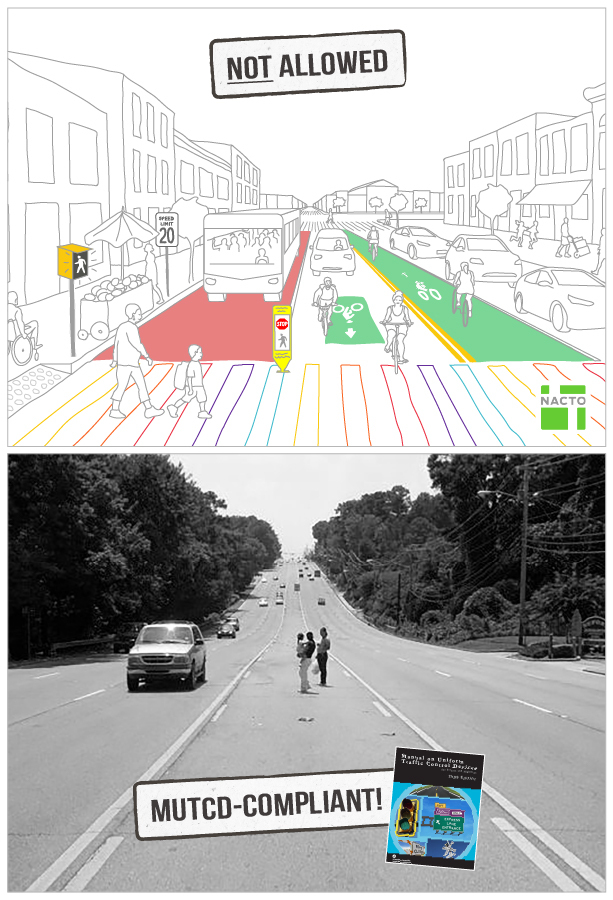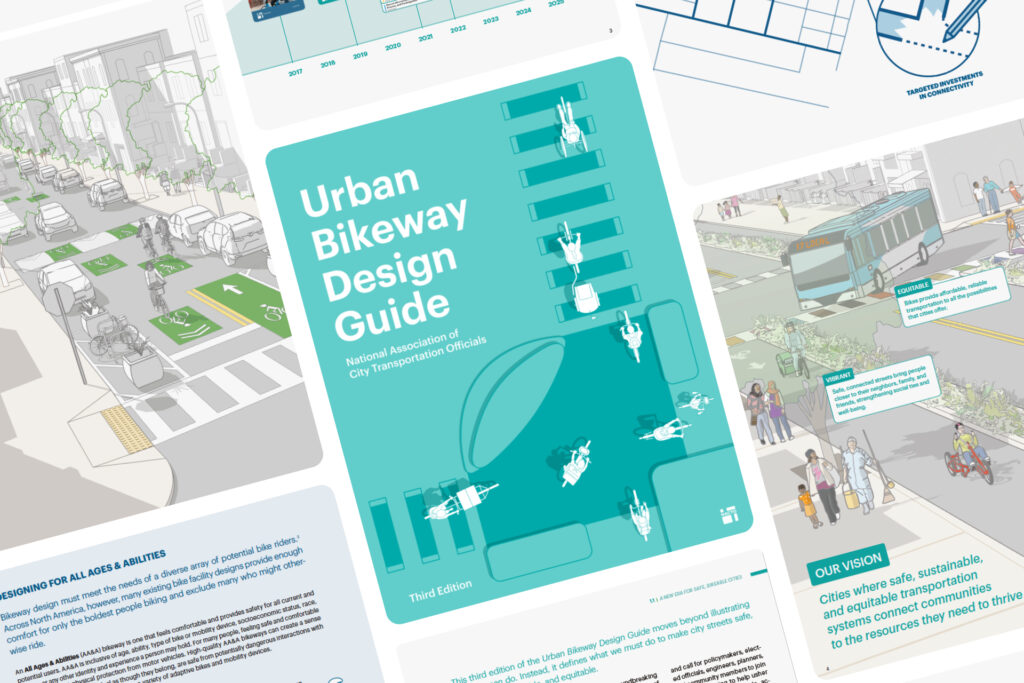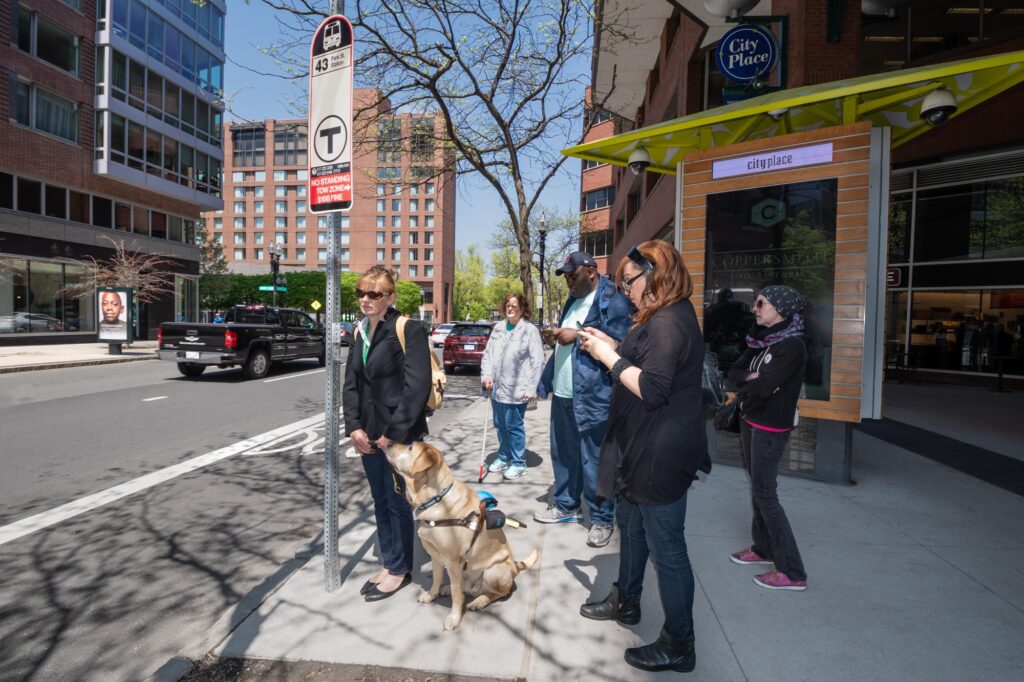Picture the last time you caught a bus, crossed a street, or rode a bike to meet a friend or make an appointment. Most likely, you encountered an unsafe intersection, waited too long at a light (or didn’t have a pedestrian signal to begin with), navigated an unsafe bike route, or found yourself stuck on a bus in mixed traffic. Planners, engineers, and advocates are working to improve these journeys, but a fundamental, federal rule book often stands in the way: the Manual on Uniform Traffic Control Devices (MUTCD).
If you’re just tuning in, here’s the rundown on the MUTCD: it’s an obscure yet important document that regulates how nearly every American street is designed, from useful elements like uniform stop signs, to absurd obstacles like counting multiple deaths at an intersection before recommending that engineers install a signal or a crosswalk. And the agency in charge of it, the Federal Highway Administration (FHWA), is in the process of updating this manual for the first time in more than a decade.

Despite an obvious need for safer streets–40,000 people die each year on American roads–the MUTCD prioritizes fast-moving vehicles over the safety and comfort of people, especially those walking, biking, and taking transit. Many regulations in the MUTCD hold back cities from building streets that work for everyone. That’s why, this winter, NACTO organized a campaign across our member cities and partner organizations to call on FHWA to update the MUTCD into a proactive, multimodal safety regulation.
To elevate the ways a reframed MUTCD is instrumental in pushing for safer, more sustainable, and equitable streets, NACTO staff and cities have shared their expertise on webinars, illustrated graphics that show the arbitrary–and often dangerous–regulations buried in the document, and contributed to articles that help spread the word about the enormous and consequential opportunity present in rethinking the MUTCD.
At the same time, NACTO completed a full review of the MUTCD’s draft 11th edition with engineers, planners, and other practitioners across our member network. Staff from our 89 member cities and transit agencies combed through over 1,000 pages of text and figures in the proposed MUTCD update and developed over 400 detailed comments, which we’ve integrated into a Change Matrix. This matrix offers comprehensive, line-by-line comments as well as higher-level reframing recommendations to inform FHWA’s revisions to the Manual.
Here are the most critical changes FHWA must make to the MUTCD:
- Elevate the goal of eliminating serious injuries and deaths: Make this goal a guiding principle of the Manual, and ensure a “safe systems” approach throughout the document.
Redefining the Manual’s primary goal and recognizing the primacy of substantive safety–even above uniformity–is essential to ensure that every regulation in the MUTCD serves to improve safety and accessibility for people. - Modernize speed limits: Remove guidance recommending the use of free-flow speeds, including the 85th percentile speed, in setting speed limits.
A substantial body of published research, including from the National Transportation Safety Board (NTSB), shows that using the 85th percentile approach to establish speed limits leads to dangerous increases in vehicular speed over time. Eliminating all guidance recommending use of free-flow speed in setting speed limits aligns with FHWA’s intent to heed the most updated and relevant safety research and signals to state DOTs that this approach is no longer nationally endorsed. - Make it safer to cross the street: Reforming signal and hybrid beacon warrants so that practitioners can install protected street crossings without requiring pedestrians to risk their lives.
The Manual’s circular signal warrants call for either a high volume of people crossing the street without a protected crossing–or, more grimly, waiting for multiple traffic injuries or deaths to occur–in order to justify installing traffic signals or beacons for pedestrians. This dangerous practice places an undue burden on people walking along our streets, often for just a few seconds saved for people driving. - Promote people over robots on our streets: Remove the Manual’s new proposed chapter on Autonomous Vehicles.
FHWA should remove this chapter, full of unfunded mandates and untested treatments. We encourage FHWA to instead consult with a diverse set of transportation practitioners, including those who build and maintain roadways in cities, on appropriate and valid requirements concerning AVs that might be incorporated into existing sections of the MUTCD. - Legalize commonsense treatments for people walking, biking, and taking transit: Remove unnecessary restrictions on the use of green paint for bike lanes, red paint for bus lanes, and other colored paint for crosswalks.
These important and heavily utilized treatments delineate street space, improve visibility for people walking, biking, and taking transit, and contribute to creating a sense of community. Even while there is no evidence to prove these designs create any adverse safety impacts, their use is heavily restricted or prohibited by the MUTCD. - Uplift best practices for bikeways, rather than prohibiting them: Eliminate geometric design restrictions for urban bikeways.
The MUTCD should refer practitioners to best practice guidance documents that have been developed with careful input from practitioners with experience and expertise in urban bikeway design, and should be treated as the standard for bikeway design in the US. - Listen to more voices: Reconcile comments and finalize the 11th edition in an inclusive and transparent manner.
In refining this edition, and for all subsequent updates, we ask FHWA to bring new, essential stakeholders into the conversation about safety on America’s roads. Only through frequent, meaningful engagement with all stakeholders, including cities and transit agencies, public health experts, childhood development specialists, experts on aging, disability advocates, and transportation safety champions, can FHWA develop an MUTCD that meets the needs of a full spectrum of roadway managers and users.
The combination of detailed line edits, recommendations on structure and frame, and suggestions for an improved process outlined in our comments would be a huge step forward for FHWA, the MUTCD, and American streets. Incorporating these comments would form the basis of a reframed, rewritten, and renewed MUTCD that prioritizes safety and the needs of more people on our streets. To continue making sure this document truly serves the current and future needs of all users, we’re looking forward to partnering on a new, more inclusive process for future updates.
For now, we will continue to update and refine these before the May 14 deadline, and will post our final comments on our website when they are submitted. Along with work from other organizations, they would help the Biden administration meet its goal to create a “road system that is designed to protect its users, through implementing life-saving…infrastructure safety solutions.”
We encourage FHWA to seize this moment to reframe the MUTCD to become a document that goes beyond merely permitting practitioners to build safer roads and instead encourages and gives them the tools to make streets in our country safer, address fundamental inequities in our transportation systems, and help us meaningfully turn the tide on climate change.
We also encourage FHWA to commit to a new, more inclusive, process for updating the MUTCD. NACTO staff, and staff in our 89 member cities, were in the position to contribute hundreds of hours of time and expertise to inform the comments we’re submitting. But, many other key stakeholders affected by the MUTCD, including advocates for youth, elderly, and/or disabled, and climate, equity, and public health experts (overstretched at this time of many overlapping crises), do not have this time. The MUTCD will be a weaker document without their valuable input.
So, next time you catch a bus, cross a street, or travel in your community, think about the MUTCD and making your voice heard. Comments on the MUTCD are due this Friday, May 14. We’ve put together a cover letter and detailed comments; and we encourage you to use these materials to ask FHWA for a document that works better for everyone.
- NACTO’s template cover letter for submitting detailed comments (docx)
- NACTO’s comment spreadsheet, which we encourage you to pull from when submitting to FHWA
A new MUTCD means cities can design safer, more sustainable, and more equitable streets. And a better future for our communities.


